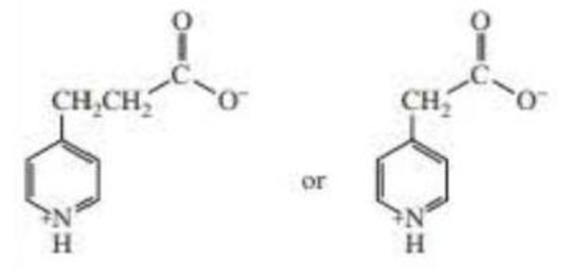
Organic Chemistry
7th Edition
ISBN: 9780321803221
Author: Paula Y. Bruice
Publisher: Prentice Hall
expand_more
expand_more
format_list_bulleted
Concept explainers
Textbook Question
Chapter 24.5, Problem 15P
Which compound is more easily decarboxylated?

Expert Solution & Answer
Learn your wayIncludes step-by-step video

schedule03:18
Students have asked these similar questions
>
You are trying to decide if there is a single reagent you can add that will make the following synthesis possible without any other
major side products:
1. ☑
CI
2. H3O+
O
Draw the missing reagent X you think will make this synthesis work in the drawing area below.
If there is no reagent that will make your desired product in good yield or without complications, just check the box under the
drawing area and leave it blank.
Click and drag to start drawing a
structure.
Explanation
Check
?
DO
18
Ar
B
© 2025 McGraw Hill LLC. All Rights Reserved. Terms of Use | Privacy Center | Accessibility
Don't use ai to answer I will report you answer
Consider a solution of 0.00304 moles of 4-nitrobenzoic acid (pKa = 3.442) dissolved in 25 mL water and titrated with 0.0991 M NaOH. Calculate the pH at the equivalence point
Chapter 24 Solutions
Organic Chemistry
Ch. 24.1 - Prob. 2PCh. 24.1 - Prob. 3PCh. 24.2 - How many conjugated double bonds are there in a....Ch. 24.2 - Instead of adding to the 4a position and...Ch. 24.2 - Prob. 7PCh. 24.3 - Prob. 8PCh. 24.3 - Acetolactate synthase is another TPP-requiring...Ch. 24.3 - Acetolactate synthase transfers the acyl group of...Ch. 24.5 - Prob. 12PCh. 24.5 - The enzyme that catalyzes the C C bond cleavage...
Ch. 24.5 - Propose a mechanism for the ,-elimination reaction...Ch. 24.5 - Which compound is more easily decarboxylated?Ch. 24.5 - Explain why the ability of PLP to catalyze an...Ch. 24.5 - Explain why the ability of PLP to catalyze an...Ch. 24.6 - Ethanolamine ammonia lyase, a coenzyme...Ch. 24.6 - Prob. 19PCh. 24.7 - How do the structure of tetrahydrofolate and...Ch. 24.7 - What is the source of the methyl group in...Ch. 24.8 - Thiols such as ethanethiol and propanethiol can be...Ch. 24 - How does the metal ion in carboxypeptidase A...Ch. 24 - Prob. 23PCh. 24 - Prob. 24PCh. 24 - Prob. 25PCh. 24 - S-Adenosylmethionine (SAM) is formed from the...Ch. 24 - Prob. 27PCh. 24 - What acyl groups have we seen transferred by...Ch. 24 - Propose a mechanism for the following reaction:Ch. 24 - When transaminated, the three branched-chain amino...Ch. 24 - Draw the products of the following reaction, where...Ch. 24 - When UMP is dissolved in T2O, exchange of T for H...Ch. 24 - Dehydratase is a PLP-requiring enzyme that...Ch. 24 - In addition to the reaction mentioned in Section...Ch. 24 - PLP can catalyze both ,-elimination reactions...Ch. 24 - The glycine cleavage system is a group of four...Ch. 24 - Prob. 37PCh. 24 - FADH2 reduces , -unsaturated thioesters to...
Additional Science Textbook Solutions
Find more solutions based on key concepts
An obese 55-year-old woman consults her physician about minor chest pains during exercise. Explain the physicia...
Biology: Life on Earth with Physiology (11th Edition)
How can the freezing of water crack boulders?
Campbell Biology in Focus (2nd Edition)
Pigeons may exhibit a checkered or plain color pattern. In a series of controlled matings, the following data w...
Concepts of Genetics (12th Edition)
[14.110] The following mechanism has been proposed for the gas-phase reaction of chloroform (CHCI3) and chlorin...
Chemistry: The Central Science (14th Edition)
15. In the Olympic shotput event, an athlete throws the shot with an initial speed of 12.0 m/s at a 40.0° angle...
Physics for Scientists and Engineers: A Strategic Approach, Vol. 1 (Chs 1-21) (4th Edition)
16. Explain some of the reasons why the human species has been able to expand in number and distribution to a g...
Campbell Biology: Concepts & Connections (9th Edition)
Knowledge Booster
Learn more about
Need a deep-dive on the concept behind this application? Look no further. Learn more about this topic, chemistry and related others by exploring similar questions and additional content below.Similar questions
- What is the name of the following compound? SiMe3arrow_forwardK Draw the starting structure that would lead to the major product shown under the provided conditions. Drawing 1. NaNH2 2. PhCH2Br 4 57°F Sunny Q Searcharrow_forward7 Draw the starting alkyl bromide that would produce this alkyne under these conditions. F Drawing 1. NaNH2, A 2. H3O+ £ 4 Temps to rise Tomorrow Q Search H2arrow_forward
arrow_back_ios
SEE MORE QUESTIONS
arrow_forward_ios
Recommended textbooks for you

Characteristic Reactions of Benzene and Phenols; Author: Linda Hanson;https://www.youtube.com/watch?v=tjEqEjDd87E;License: Standard YouTube License, CC-BY
An Overview of Aldehydes and Ketones: Crash Course Organic Chemistry #27; Author: Crash Course;https://www.youtube.com/watch?v=-fBPX-4kFlw;License: Standard Youtube License